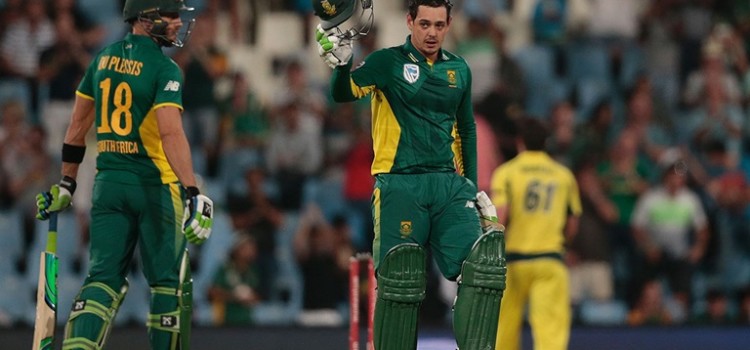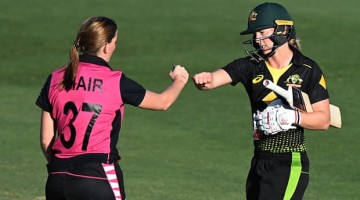
Hurricane de Kock destroys Australia
Having taunted the reigning ODI world champions with his tongue earlier in the week, South Africa opener Quinton de Kock stepped up the savagery with his bat in a remarkable display of hitting at Centurion this evening.
A career-best 178 from 113 balls not only lifted the Proteas to a crushing six-wicket win in the first outing of the five-match ODI Series, it spelled out a very clear challenge to Australia’s revamped bowling attack.
That the absence of strike bowlers Mitchell Starc and Josh Hazlewood means South Africa’s batters carry no fear, even with a couple of their most potent one-day batsmen missing from today’s game.
De Kock has often been criticised, occasionally ostracised, for not making the most of his unquestioned talent and has spent periods on the outer of South Africa’s Test and limited-overs outfits.
Quick Single: The records that de Kock demolished
He was even quoted as suggesting some Australian players were using injury as a reason to take time out of the gruelling international schedule that sees them in South Africa just weeks after their two-month visit to Sri Lanka.
But rather like former opener Herschelle Gibbs, the man he this evening ousted as owner of the highest score by a South African in an ODI against Australia, it would seem that consistency is the only obvious flaw in an otherwise complete batting repertoire.
Given that South Africa completed their pursuit with almost 15 overs to spare and just as de Kock was warming to his work – his final 78 runs coming from just 39 balls with seven sixes – it’s not unreasonable to think he might have surpassed the record ODI score of 264 set by India’s Rohit Sharma had his team been set a loftier pursuit.
And had he not holed out to a clever diving catch at deep backward square for the second-highest one-day score by a South African batsman – which remains Gary Kirsten’s 188 against the UAE in the 1996 World Cup – having clubbed an extraordinarily diverse range of 16 boundaries and 11 sixes.
While his cause was doubtless aided by some lacklustre bowling and sloppy fielding – the most costly being Mitchell Marsh’s attempted overhead mark at deep fine leg that spilled over the boundary when de Kock was 57 – so crisp was his stroke play that most of the Australians ran to congratulate him on his knock when he surrendered his wicket.
Shortly before they retired to their dressing room to contemplate the scope of their defeat – the six-wicket loss being the heftiest defeat they’ve suffered having posted a score above 275 since South Africa chased down 327 for the loss of only three wickets in Harare two years ago.
When de Kock and his opening partner Rilee Rossouw were flaying the tourists all over Centurion in the opening hour it seemed that margin might be 10 wickets.
Rossouw was not named in the initial squad for the five-match series against Australia as he was not deemed to have fully recovered the dislocated right shoulder he suffered while playing against the same opponent during the recent ODI tri-series in the Caribbean.
He was added when the Proteas’ skipper AB de Villiers was ruled out of the campaign – and the next two months – earlier in the week because of impending surgery to fix a painful elbow complaint.
If the Australians privately felt that was a stroke of good fortune, they were very publicly treated to an array of strokes that highlighted it was anything but.
Rossouw and de Kock flew past 50 in the seventh over, beyond 100 in the 14th and would have likely reeled in the world champions’ tally with about 10 overs to spare if the former had not succumbed to ambition.
The reverse sweep he aimed at Adam Zampa’s opening delivery brought Australia’s sole joy in more than an hour of toil, and vindicated those who felt the leg-spinner might have been employed earlier.
Although Zampa’s skipper was clearly of the view that turning the ball into a pair of left-handers in such murderous form threatened a fast-track to failure.
As it turned out, that was the very path the Australians found themselves as Rossouw’s removal only egged on de Kock who reached his century in the most emphatic manner.
Crunching new cap Dan Worrall over the rope, fence, baying fans and very nearly the rolling grass embankment at mid-wicket with one of the cleanest strikes of his bludgeoning 74-ball knock to that moment.
A pummelling that continued unabated until he departed the field to rapturous scenes in the 34th over.
Along the way the 23-year-old provided a master class for the Australian top-order who had all made starts but failed to cash in on the sort of perfect batting wicket they spent the previous two months craving.
The left-hander picked the gaps adroitly at the start of his innings, muscled the ball more violently as the field restrictions were lifted and then heaped humiliation on a hapless attack as he single-handedly made a mockery of the target that a decade ago would have appeared laughably large.
Upon initial glance, Australia’s 50-over tally of 294 appeared challenging if not outright formidable given that only two teams had successfully chased down bigger scores in almost 40 ODIs played at Centurion.
Less reassuring was the knowledge one of those teams was the current iteration of South Africa against England in the most recent one-dayer at the venue, largely on the back of a 239-run opening stand between de Kock and Hashim Amla.
Amla’s withdrawal from the match due to a viral infection – as well as the longer-term absence of AB de Villiers because of elbow surgery – might have mitigated some of the tourists’ apprehension.
But they would have begun their bowling innings in front of a heaving local crowd nursing a nagging feeling they had pulled up 30-40 runs shy of where they might have ended given the speed of their start.
Jet propelled by David Warner who outscored his recalled opening partner Aaron Finch 36 runs to eight when the pair reached 50 for the first wicket (after eight overs), the Australians maintained a scoring rate of a run per ball for much of the first half of their innings.
However, as the road safety warnings tell us with haste comes carelessness and every time the world champions appeared set to grab a hold of the game another wicket fell off the back.
Warner miscued to mid-off trying to force on the rise, and Finch fell to a line-ball ground-level catch that Wayne Parnell smartly plucked at short fine leg to slow the charge.
Finch’s wicket was the first in international cricket for 20-year-old all-rounder Andile Phehlukwayo, a member of South Africa’s triumphant Under-19 World Cup squad in 2014, but his second that arrived three balls later is one he’s likely to treasure through to retirement
When he beat the bat of Steve Smith, who seemed so affronted by the youngster’s temerity that he wasted his team’s sole review on a delivery headed for the top of middle, with the Australia needing to view just one slow motion replay on the big screed to realise he had erred.
Having got off the mark with an imperious flick for six beyond backward square, Mitchell Marsh maintained the momentum with 31 from 25 balls until his guided a catch to the keeper.
And Travis Head fell in fashion hauntingly similar to the recent Sri Lanka adventure when he failed to read – or reach – leg spinner Imran Tahir’s wrong-un and was smartly stumped.
Throughout much of this flurry that saw Australia in danger of being prematurely bowled out at 5-172 midway through their 50-over complement stood George Bailey, taking his time to find his tempo and his range.
Not that his knock was devoid of risk.
Not for his batting partners, anyway.
A misjudged single in the 21st over would have accounted for Travis Head had Parnell’s throw hit the stumps, and another one seven overs later did for Matthew Wade who departed the middle with more than a few words of advice for his fellow Tasmanian.
But true to character, Bailey did not allow a couple of setbacks ruffle him from his task.
He fashioned a crucial if conservative 79-run union with John Hastings for the seventh wicket that saw Hastings post his maiden ODI half-century at a scoring rate almost double that of his specialist batting partner.
However, having carried Australia into the final five overs with a few wickets up their sleeve, the innings then misfired on re-entry as a succession of batters holed out in the final phase with just 23 runs scored from the last 30 deliveries.
Two of which yielded wickets for Dale Steyn on his return to the Proteas’ ODI line-up, his first one-day scalps in almost a year salving the reality they both came via wild slogs to the outfield to end a spell that cost 65 runs.
His second-most expensive in 21 ODIs against his arch-rivals.
Categories: Cricket



